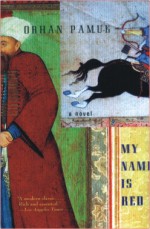| Book Review
My name is Red
by Orhan Pamuk
Reviewed by Efadul Huq
 'I am nothing but a corpse now, a body at the bottom of a well', reads the first line of Noble Laureate Orhan Pamuk's My Name Is Red, pulling you into a philosophical murder mystery. 'I am nothing but a corpse now, a body at the bottom of a well', reads the first line of Noble Laureate Orhan Pamuk's My Name Is Red, pulling you into a philosophical murder mystery.
The Sultan commissions an illustrated book to make obvious his power and to glorify his kingdom. Moreover this grand work of art will be illuminated in the European style. As figurative art is an affront to Islam, this indeed, is a risky mission to undertake. The project falls on the shoulder of Enishte, who coordinates miniaturists nicknamed Elegant, Stork, Olive, and Butterfly. But when Elegant suspects the orthodoxy of the final page and threatens to denounce the project to the followers of the preacher Nusret Hoja, he is murdered by one of his colleagues. Enishte's nephew Black, who newly returned to Istanbul after twelve years of disappearance, is asked to investigate. To complicate things, Black revives an old passion for Enishte's daughter Shekure, who is technically still married to a husband missing in battle, and who has other suitors.
My Name Is Red is a novel told by more than a dozen narrators including a dog, a horse, a tree and a coin. This particular aspect of the novel entertains the readers with the many perspectives it presents. Looking at a murder from the point of views of several characters is amusing indeed and the amusement compels any reader to hold on to the book. As it must be clear by now, all the chapters are first person narratives, lending a unique pace to the novel. You have no chance to feel bored as each individual opens their heart to you.
The novel begins dramatically, as the spirit of late Elegant Effendi talks about himself. And this sense of drama is present on each page, continuing till the end. Even the killer has his anonymous chapters!
My Name is Red is very much a book about art, about what the purpose of art is and about its dangers. There is a good deal of discussion about paintings, and about what makes real art. Pamuk offers some splendid details here, from what the miniaturists do to avoid going blind (face away from the sun when it rises, among other things) to the idea that only in blindness does pure art
Central to the novel is the contest between the old and new, tradition and change, East and West! From artists who are mere copyists to those who want to apply the new methods of the Western masters (including the use of perspective) there is incredible tension. Who victors the conflict is a question of interest by itself!
All these debates and the varieties of approaches to artistic production (from imitation to innovation) as well as the artist's life at a time and place like that are well-conveyed by Pamuk, and much is fascinating. His descriptions are evocative and Pamuk paid a great deal of attention to a variety of different complementary details and like a master he repeatedly used similar scenes and motifs to create different effects.
My Name Is Red is thought provoking and brings its reader face-to-face with Islamic art at its greatest height! Reading and re-reading this book is WORTH the effort.
The book is available at Friends' Book Corner, Nilkhet.
efahuq@gmail.com
Copyright
(R) thedailystar.net 2007 |
